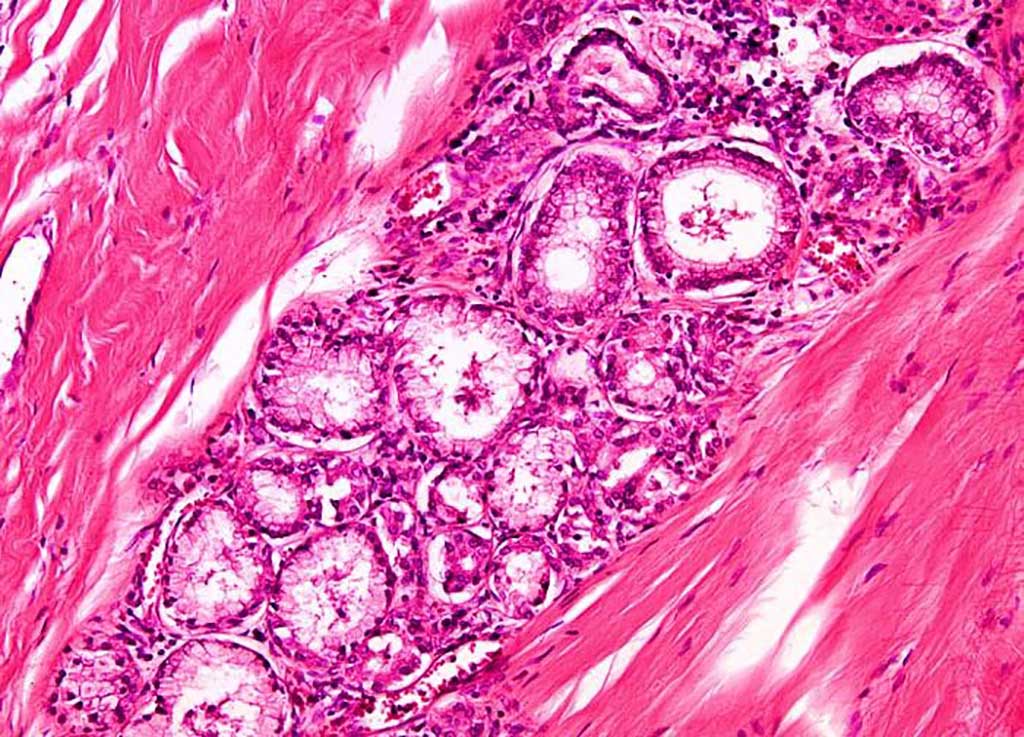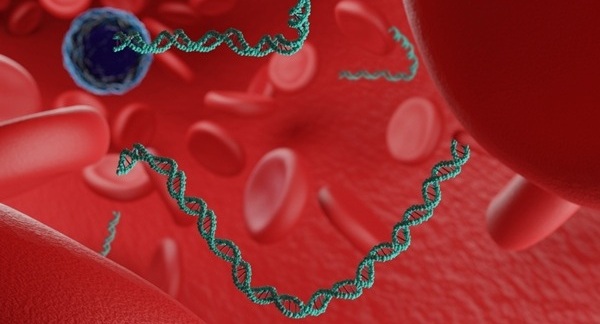Lung Adenocarcinoma Genomic Features Differ in East Asians, Europeans
|
By LabMedica International staff writers Posted on 18 Feb 2020 |

Image: Histopathology of Lung adenocarcinoma (Photo courtesy of Nikon).
Lung adenocarcinoma is a subtype of non-small cell lung cancer (NSCLC). Lung adenocarcinoma is categorized as such by how the cancer cells look under a microscope. Lung adenocarcinoma starts in glandular cells, which secrete substances such as mucus, and tends to develop in smaller airways, such as alveoli.
Lung cancer is the world’s leading cause of cancer death and shows strong ancestry disparities. Lung adenocarcinoma is a common cancer and leads to more than one million deaths each year. A new analysis has found that lung tumors isolated from patients of East Asian ancestry have a less complex genomic architecture than tumors from European patients.
Scientists from the Genome Institute of Singapore (A*STAR, Singapore) and their associates characterized the genomic landscape of lung cancer among East Asians, generating a genomic and transcriptomic dataset encompassing more than 300 lung cancer patients of Chinese ancestry. They sequenced the exomes and transcriptomes of 213 Chinese lung adenocarcinoma patients from Singapore and combined that dataset with previously published whole-exome sequencing data on 92 Chinese patients from another cohort. By comparing the genomic and transcriptomic data from these 305 individuals to that of 249 lung adenocarcinoma patients of European ancestry from The Cancer Genome Atlas, they uncovered differences in tumor mutational burden and driver genes between the groups.
The team reported that overall, East Asian patients' tumors had fewer genomic alterations, with a median tumor mutational burden of 2.04 per Mb, as compared to a median 5.08 per Mb among European patients. While this burden was influenced by patients' smoking status, even among smokers, East Asian patients had a lower median tumor mutational burden than European patients. At the same time, the number and nature of driver mutations differed between tumors from East Asian and European patients. In East Asian patients, alterations affecting the EGFR, TP53, and KRAS genes were the most common driver mutations and nonsmokers had an average 2.08 driver mutations, as compared to an average 2.65 driver mutations among European nonsmokers. Additionally, East Asian patients had fewer copy number variations.
By analyzing the transcriptomic profiles of the tumor samples, the scientists teased out three different lung cancer sub-clusters. Two of these were similar to the terminal respiratory unit (TRU) and proximal inflammatory sub-clusters previously found in European patients, but the third was specific to East Asians. That sub-cluster, dubbed TRU-I, was marked by the upregulation of inflammation-associated genes and increased immune infiltration. This phenotype could help identify patients who might be more likely to benefit from immunotherapy or immune checkpoint blockade treatment.
While they found that patients' clinical features could predict their outcomes, they noted that genomic features could also predict patient survival. These predictions were more accurate for East Asian than European patients, which they attributed to their more stable tumor genomes. The authors concluded that their study elucidated a comprehensive genomic landscape of East Asian ancestry lung adenocarcinomas and highlighted important ancestry differences between the two cohorts. The study was published on February 3, 2020 in the Nature Genetics.
Related Links:
Genome Institute of Singapore
Lung cancer is the world’s leading cause of cancer death and shows strong ancestry disparities. Lung adenocarcinoma is a common cancer and leads to more than one million deaths each year. A new analysis has found that lung tumors isolated from patients of East Asian ancestry have a less complex genomic architecture than tumors from European patients.
Scientists from the Genome Institute of Singapore (A*STAR, Singapore) and their associates characterized the genomic landscape of lung cancer among East Asians, generating a genomic and transcriptomic dataset encompassing more than 300 lung cancer patients of Chinese ancestry. They sequenced the exomes and transcriptomes of 213 Chinese lung adenocarcinoma patients from Singapore and combined that dataset with previously published whole-exome sequencing data on 92 Chinese patients from another cohort. By comparing the genomic and transcriptomic data from these 305 individuals to that of 249 lung adenocarcinoma patients of European ancestry from The Cancer Genome Atlas, they uncovered differences in tumor mutational burden and driver genes between the groups.
The team reported that overall, East Asian patients' tumors had fewer genomic alterations, with a median tumor mutational burden of 2.04 per Mb, as compared to a median 5.08 per Mb among European patients. While this burden was influenced by patients' smoking status, even among smokers, East Asian patients had a lower median tumor mutational burden than European patients. At the same time, the number and nature of driver mutations differed between tumors from East Asian and European patients. In East Asian patients, alterations affecting the EGFR, TP53, and KRAS genes were the most common driver mutations and nonsmokers had an average 2.08 driver mutations, as compared to an average 2.65 driver mutations among European nonsmokers. Additionally, East Asian patients had fewer copy number variations.
By analyzing the transcriptomic profiles of the tumor samples, the scientists teased out three different lung cancer sub-clusters. Two of these were similar to the terminal respiratory unit (TRU) and proximal inflammatory sub-clusters previously found in European patients, but the third was specific to East Asians. That sub-cluster, dubbed TRU-I, was marked by the upregulation of inflammation-associated genes and increased immune infiltration. This phenotype could help identify patients who might be more likely to benefit from immunotherapy or immune checkpoint blockade treatment.
While they found that patients' clinical features could predict their outcomes, they noted that genomic features could also predict patient survival. These predictions were more accurate for East Asian than European patients, which they attributed to their more stable tumor genomes. The authors concluded that their study elucidated a comprehensive genomic landscape of East Asian ancestry lung adenocarcinomas and highlighted important ancestry differences between the two cohorts. The study was published on February 3, 2020 in the Nature Genetics.
Related Links:
Genome Institute of Singapore
Latest Pathology News
- Genetics and AI Improve Diagnosis of Aortic Stenosis
- AI Tool Simultaneously Identifies Genetic Mutations and Disease Type
- Rapid Low-Cost Tests Can Prevent Child Deaths from Contaminated Medicinal Syrups
- Tumor Signals in Saliva and Blood Enable Non-Invasive Monitoring of Head and Neck Cancer
- Common Health Issues Can Influence New Blood Tests for Alzheimer’s Disease
- Blood Test Formula Identifies Chronic Liver Disease Patients with Higher Cancer Risk
- Tunable Cell-Sorting Device Holds Potential for Multiple Biomedical Applications
- AI Tool Outperforms Doctors in Spotting Blood Cell Abnormalities
- AI Tool Rapidly Analyzes Complex Cancer Images for Personalized Treatment
- Diagnostic Technology Performs Rapid Biofluid Analysis Using Single Droplet
- Novel Technology Tracks Hidden Cancer Cells Faster
- AI Tool Improves Breast Cancer Detection
- AI Tool Predicts Treatment Success in Rectal Cancer Patients
- Blood Test and Sputum Analysis Predict Acute COPD Exacerbation
- AI Tool to Transform Skin Cancer Detection with Near-Perfect Accuracy
- Unique Immune Signatures Distinguish Rare Autoimmune Condition from Multiple Sclerosis
Channels
Clinical Chemistry
view channel
Blood Test Could Predict and Identify Early Relapses in Myeloma Patients
Multiple myeloma is an incurable cancer of the bone marrow, and while many patients now live for more than a decade after diagnosis, a significant proportion relapse much earlier with poor outcomes.... Read more
Compact Raman Imaging System Detects Subtle Tumor Signals
Accurate cancer diagnosis often depends on labor-intensive tissue staining and expert pathological review, which can delay results and limit access to rapid screening. These conventional methods also make... Read moreHematology
view channel
MRD Tests Could Predict Survival in Leukemia Patients
Acute myeloid leukemia is an aggressive blood cancer that disrupts normal blood cell production and often relapses even after intensive treatment. Clinicians currently lack early, reliable markers to predict... Read more
Platelet Activity Blood Test in Middle Age Could Identify Early Alzheimer’s Risk
Early detection of Alzheimer’s disease remains one of the biggest unmet needs in neurology, particularly because the biological changes underlying the disorder begin decades before memory symptoms appear.... Read more
Microvesicles Measurement Could Detect Vascular Injury in Sickle Cell Disease Patients
Assessing disease severity in sickle cell disease (SCD) remains challenging, especially when trying to predict hemolysis, vascular injury, and risk of complications such as vaso-occlusive crises.... Read more
ADLM’s New Coagulation Testing Guidance to Improve Care for Patients on Blood Thinners
Direct oral anticoagulants (DOACs) are one of the most common types of blood thinners. Patients take them to prevent a host of complications that could arise from blood clotting, including stroke, deep... Read moreImmunology
view channel
Ultrasensitive Liquid Biopsy Demonstrates Efficacy in Predicting Immunotherapy Response
Immunotherapy has transformed cancer treatment, but only a small proportion of patients experience lasting benefit, with response rates often remaining between 10% and 20%. Clinicians currently lack reliable... Read more
Blood Test Could Identify Colon Cancer Patients to Benefit from NSAIDs
Colon cancer remains a major cause of cancer-related illness, with many patients facing relapse even after surgery and chemotherapy. Up to 40% of people with stage III disease experience recurrence, highlighting... Read moreMicrobiology
view channel
New UTI Diagnosis Method Delivers Antibiotic Resistance Results 24 Hours Earlier
Urinary tract infections affect around 152 million people every year, making them one of the most common bacterial infections worldwide. In routine medical practice, diagnosis often relies on rapid urine... Read more
Breakthroughs in Microbial Analysis to Enhance Disease Prediction
Microorganisms shape human health, ecosystems, and the planet’s climate, yet identifying them and understanding how they are related remains a major scientific challenge. Even with modern DNA sequencing,... Read morePathology
view channel
Genetics and AI Improve Diagnosis of Aortic Stenosis
Aortic stenosis is a progressive narrowing of the aortic valve that restricts blood flow from the heart and can be fatal if left untreated. There are currently no medical therapies that can prevent or... Read more
AI Tool Simultaneously Identifies Genetic Mutations and Disease Type
Interpreting genetic test results remains a major challenge in modern medicine, particularly for rare and complex diseases. While existing tools can indicate whether a genetic mutation is harmful, they... Read more
Rapid Low-Cost Tests Can Prevent Child Deaths from Contaminated Medicinal Syrups
Medicinal syrups contaminated with toxic chemicals have caused the deaths of hundreds of children worldwide, exposing a critical gap in how these products are tested before reaching patients.... Read more
Tumor Signals in Saliva and Blood Enable Non-Invasive Monitoring of Head and Neck Cancer
Head and neck cancers are among the most aggressive malignancies worldwide, with nearly 900,000 new cases diagnosed each year. Monitoring these cancers for recurrence or relapse typically relies on tissue... Read moreTechnology
view channel
Pioneering Blood Test Detects Lung Cancer Using Infrared Imaging
Detecting cancer early and tracking how it responds to treatment remains a major challenge, particularly when cancer cells are present in extremely low numbers in the bloodstream. Circulating tumor cells... Read more
AI Predicts Colorectal Cancer Survival Using Clinical and Molecular Features
Colorectal cancer is one of the most common and deadly cancers worldwide, and accurately predicting patient survival remains a major clinical challenge. Traditional prognostic tools often rely on either... Read moreIndustry
view channel
BD and Penn Institute Collaborate to Advance Immunotherapy through Flow Cytometry
BD (Becton, Dickinson and Company, Franklin Lakes, NJ, USA) has entered into a strategic collaboration with the Institute for Immunology and Immune Health (I3H, Philadelphia, PA, USA) at the University... Read more









 assay.jpg)









